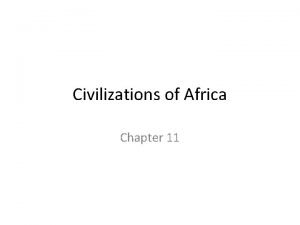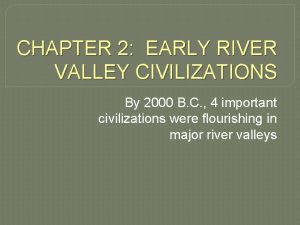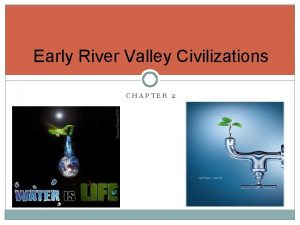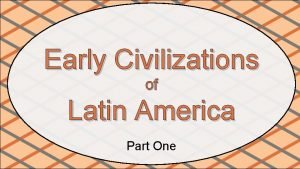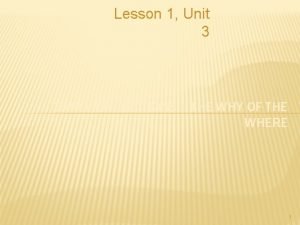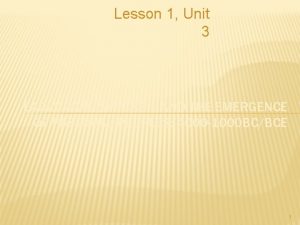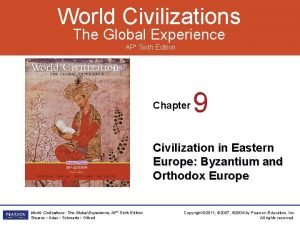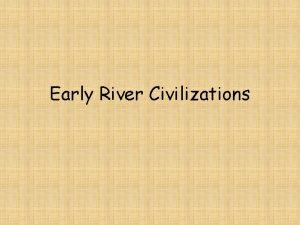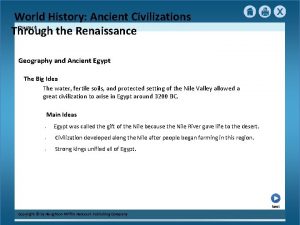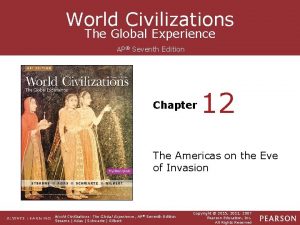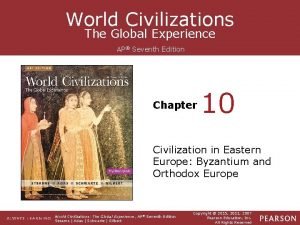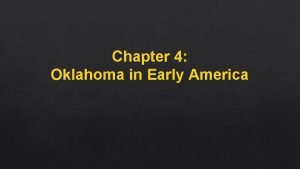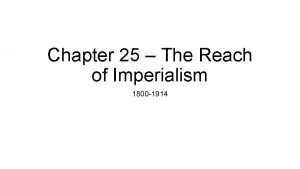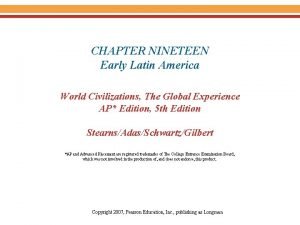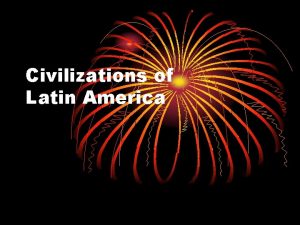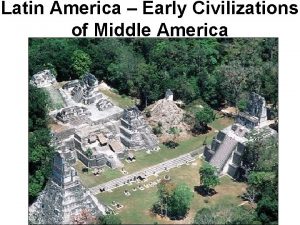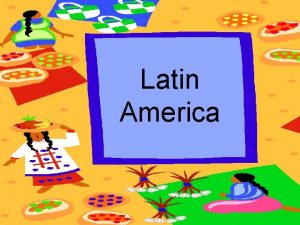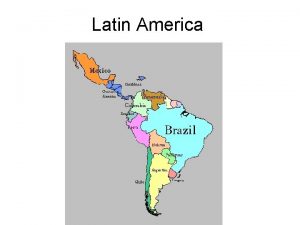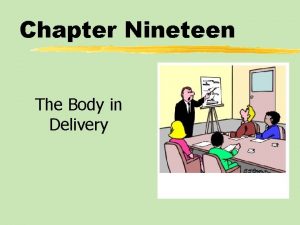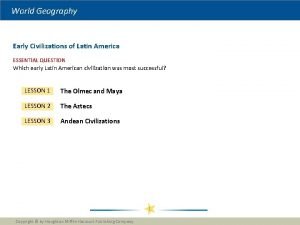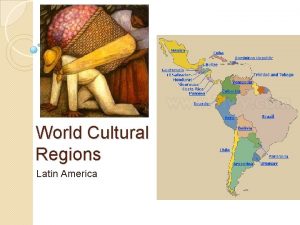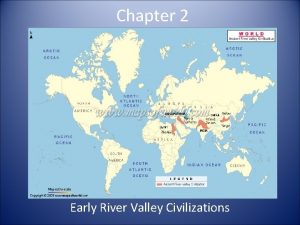CHAPTER NINETEEN Early Latin America World Civilizations The

















- Slides: 17

CHAPTER NINETEEN Early Latin America World Civilizations, The Global Experience AP* Edition, 5 th Edition Stearns/Adas/Schwartz/Gilbert *AP and Advanced Placement are registered trademarks of The College Entrance Examination Board, which was not involved in the production of, and does not endorse, this product. Copyright 2007, Pearson Education, Inc. , publishing as Longman

Chapter 19: Early Latin America I. Spaniards and Portuguese: From Reconquest to Conquest II. The Destruction and Transformation of American Indian Societies III. Colonial Economies and Governments IV. Brazil: The First Plantation Economy V. Multiracial Societies VI. The 18 th-Century Reforms Stearns et al. , World Civilizations, The Global Experience, AP* Edition, 5 th Edition Pearson Education, Inc. publishing as Longman, Copyright 2007

Chapter 19: Early Latin America I. Spaniards and Portuguese: From Reconquest to Conquest Iberia Zone of cultural contact Arab Muslims invade in 8 th century Long multicultural period Reconquest Small Christian states to unification 1492, completed Jews expelled A. Iberian Society and Tradition Features Strongly urbanized Iberian commoners seek to raise their status Encomiendas (large estates) Patriarchal culture Slavery Centralized governments Close ties to church Stearns et al. , World Civilizations, The Global Experience, AP* Edition, 5 th Edition Pearson Education, Inc. publishing as Longman, Copyright 2007

Chapter 19: Early Latin America I. Spaniards and Portuguese: From Reconquest to Conquest B. The Chronology of Conquest First stage, 1492 -1570 Foundations Second stage, 1570 -1700 New society, institutions take shape Third stage, 1700 s Reform, reorganization Discontent, unrest Spanish and Portuguese Exploration, 1400 -1600 C. The Caribbean Crucible Native Indians become laborers Decimated by disease Cities Grid Central plaza Professional bureaucrats 16 th century African slaves, Spanish women new society Bartolomé de las Casas Opposes abuses of Indians Stearns et al. , World Civilizations, The Global Experience, AP* Edition, 5 th Edition Pearson Education, Inc. publishing as Longman, Copyright 2007

Chapter 19: Early Latin America I. Spaniards and Portuguese: From Reconquest to Conquest D. The Paths of Conquest Not unified Mexico 1519, Hernán Cortés into Mexico Attacks Aztecs Tenochtitlan Moctezuma II killed By 1535, central Mexico under Spain Kingdom of New Spain Inca Weakened by civil war Francisco Pizarro 1532, begins conquest Cuzco falls, 1533 New capital at Lima Stearns et al. , World Civilizations, The Global Experience, AP* Edition, 5 th Edition Pearson Education, Inc. publishing as Longman, Copyright 2007

Chapter 19: Early Latin America I. Spaniards and Portuguese: From Reconquest to Conquest D. The Paths of Conquest American Southwest Francisco Vázquez de Coronado Exploration in the 1540 s Chile Pedro de Valdivia Conquers central Chile 1541, founds Santiago By 1570, 192 Spanish towns Stearns et al. , World Civilizations, The Global Experience, AP* Edition, 5 th Edition Pearson Education, Inc. publishing as Longman, Copyright 2007

Chapter 19: Early Latin America I. Spaniards and Portuguese: From Reconquest to Conquest F. The Conquerors Contracts between crown and leaders of expeditions Followers get booty G. Conquest and Morality Conquests questioned Indians considered sub-human Conversion a duty Las Casas' work lessens abuses Stearns et al. , World Civilizations, The Global Experience, AP* Edition, 5 th Edition Pearson Education, Inc. publishing as Longman, Copyright 2007

Chapter 19: Early Latin America II. The Destruction and Transformation of American Indian Societies The example of Mexico Indigenous population 25 million to fewer than 2 million A. Exploitation of the Indians Encomiendas Adds to decline of native populations Modified by crown, fearing threat Mita Native system of forced labor Natives used for state projects Stearns et al. , World Civilizations, The Global Experience, AP* Edition, 5 th Edition Population Decline in New Spain Pearson Education, Inc. publishing as Longman, Copyright 2007

Chapter 19: Early Latin America III. Colonial Economies and Governments 80 percent work in agriculture, ranching Mining crucial A. The Silver Heart of Empire Mexico, Peru Potosí, Bolivia Largest Zacatecas, Mexico B. Haciendas and Villages Haciendas Spanish agricultural estates Produce for domestic use Give rise to aristocracy Stearns et al. , World Civilizations, The Global Experience, AP* Edition, 5 th Edition Pearson Education, Inc. publishing as Longman, Copyright 2007

Chapter 19: Early Latin America III. Colonial Economies and Governments C. Industry and Commerce Sheep raising Textile sweatshops Silver trade preeminent Only for Spaniards Convoys cross Atlantic Protected by galleons Board of Trade Oversees commerce Consulado, merchant guild Silver Production in Spanish America 1516 -1660 Stearns et al. , World Civilizations, The Global Experience, AP* Edition, 5 th Edition Pearson Education, Inc. publishing as Longman, Copyright 2007

Chapter 19: Early Latin America III. Colonial Economies and Governments D. Ruling an Empire: State and Church Treaty of Tordesillas, 1494 Spain and Portugal gets Brazil Rest to Spain Spanish Empire King at top Council of Indies Viceroyalties Mexico City, Lima Clergy Religious and secular functions Inquisition Stearns et al. , World Civilizations, The Global Experience, AP* Edition, 5 th Edition Pearson Education, Inc. publishing as Longman, Copyright 2007

Chapter 19: Early Latin America IV. Brazil: The First Plantation Economy 1500, Pedro Alvares Cabral Only interested in dyewoods 1532, new system developed Spurred by French interest Land grants to increase colonization 1549, governor creates administration Capital at Salvador A. Sugar and Slavery Sugar Labor intensive Society White plantation-owners dominate Slaves at bottom Great variety in between Administration Staffed by lawyers Regional governors run AP* Edition, 5 th Edition Stearns et al. , World Civilizations, Missionaries The Global Experience, Pearson Education, Inc. publishing as Longman, Copyright 2007

Chapter 19: Early Latin America IV. Brazil: The First Plantation Economy B. Brazil's Age of Gold European conflict affects Brazil, 1600 s Dutch occupy Brazil until 1654 Dutch, English, French Sugar plantations in Caribbean Price of sugar drops, slaves more expensive Paulistas Explorers into interior Discover gold, Minas Gerais, 1695 Government controls production Interior developed Rio de Janeiro Closer to mines Stearns et al. , World Civilizations, The Global Experience, AP* Edition, 5 th Edition Pearson Education, Inc. publishing as Longman, Copyright 2007

Chapter 19: Early Latin America V. Multiracial Societies Castas, mixed races A. The Society of Castas Miscengenation Sexual exploitation of Indian women Mestizo population Peninsulares v. creoles Stearns et al. , World Civilizations, The Global Experience, AP* Edition, 5 th Edition Pearson Education, Inc. publishing as Longman, Copyright 2007

Chapter 19: Early Latin America VI. The 18 th-Century Reforms A. The Shifting Balance of Politics and Trade Spain weakened in 18 th century Conflict with France, England, Holland Loss of overseas territories Silver imports drop Colonies more selfsufficient 1701 -1713, War of the Spanish Succession Bourbons victorious Stearns et al. , World Civilizations, The Global Experience, AP* Edition, 5 th Edition Pearson Education, Inc. publishing as Longman, Copyright 2007

Chapter 19: Early Latin America VI. The 18 th-Century Reforms B. The Bourbon Reforms Charles III (1759 1788) Reforms Jesuits expelled from Spain, empire, 1767 French forms introduced José de Gálvez Reforms Creoles lose high office Spain and France allied now Spain involved in Anglo-French wars Seven Years War English take Havana Reaction Better defenses of New World territory Frontiers extended California settled State takes more Stearns et al. , World Civilizations, The Global Experience, AP* Edition, 5 th Edition Pearson Education, Inc. publishing as Longman, Copyright 2007

Chapter 19: Early Latin America VI. The 18 th-Century Reforms C. Pombal and Brazil Marquis of Pombal, 1755 to 1776 Authoritarian Jesuits expelled from empire, 1759 Reforms Monopoly companies to develop agriculture Rio de Janeiro the new capital Slavery abolished in Portugal D. Reforms, Reactions, and Revolts Mid-18 th century Great economic growth Population, production up Traditional leaders threatened by reforms New Granada Comunero Revolt, 1781 Stearns et al. , World Civilizations, The Global Experience, AP* Edition, 5 th Edition Pearson Education, Inc. publishing as Longman, Copyright 2007
 Why is it called latin america
Why is it called latin america Lesson 1 early civilizations
Lesson 1 early civilizations Chapter 11 section 1 early civilizations of africa
Chapter 11 section 1 early civilizations of africa Lesson quiz 14-2 pre-columbian america answers
Lesson quiz 14-2 pre-columbian america answers River valley civilizations def
River valley civilizations def Chapter 2 early river valley civilizations
Chapter 2 early river valley civilizations Early south american civilizations
Early south american civilizations Geographic luck definition
Geographic luck definition Lesson 1 early civilizations
Lesson 1 early civilizations Rap of the map of the us
Rap of the map of the us World civilizations the global experience ap edition
World civilizations the global experience ap edition World civilizations the global experience 7th edition
World civilizations the global experience 7th edition River valley civilization
River valley civilization Ancient civilizations through the renaissance
Ancient civilizations through the renaissance Twantinsuyu
Twantinsuyu World civilizations the global experience 7th edition
World civilizations the global experience 7th edition Chapter 4 oklahoma in early america
Chapter 4 oklahoma in early america Chapter 25 the reach of imperialism
Chapter 25 the reach of imperialism


